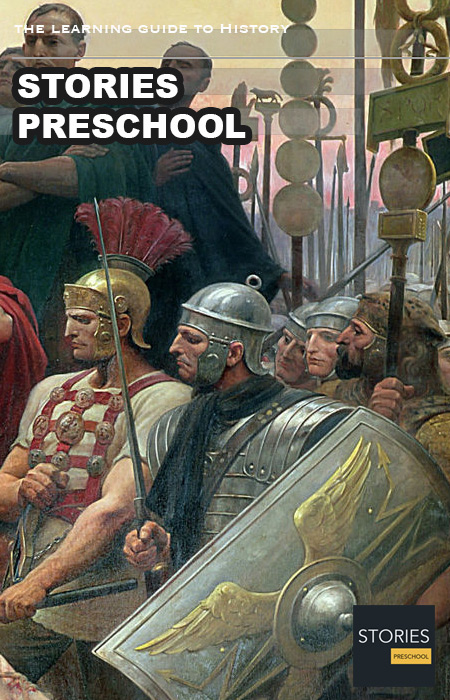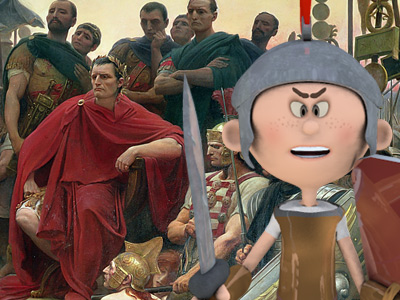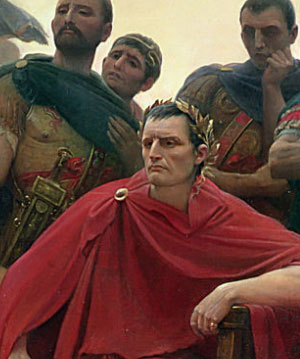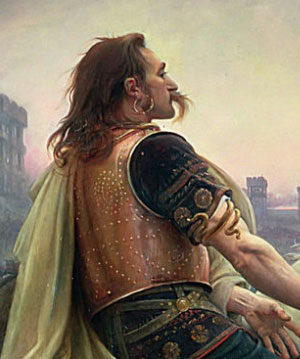Gallic Wars (58–50 BC)
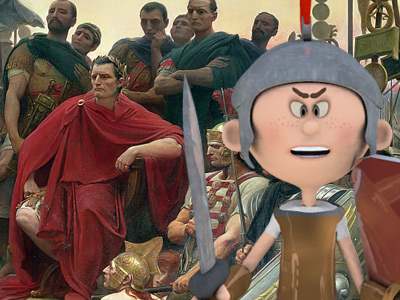
The Gallic Wars were a series of military campaigns waged by the Roman proconsul Julius Caesar against several Gallic tribes. Rome's war against the Gallic tribes lasted from 58 BC to 50 BC and culminated in the decisive Battle of Alesia in 52 BC, in which a complete Roman victory resulted in the expansion of the Roman Republic over the whole of Gaul (mainly present-day France France, officially the French Republic is transcontinental country predominantly located in Western Europe and spanning overseas regions and territories in the Americas and the Atlantic, Pacific and Indian Oceans. France reached its political and military zenith in the early 19th century under Napoleon Bonaparte, subjugating much of continental Europe and establishing the First French Empire. and Belgium
France, officially the French Republic is transcontinental country predominantly located in Western Europe and spanning overseas regions and territories in the Americas and the Atlantic, Pacific and Indian Oceans. France reached its political and military zenith in the early 19th century under Napoleon Bonaparte, subjugating much of continental Europe and establishing the First French Empire. and Belgium Belgium, officially the Kingdom of Belgium, is a country in Northwestern Europe. The country as it exists today was established following the 1830 Belgian Revolution. Belgium has also been the battleground of European powers, earning the moniker the "Battlefield of Europe", a reputation reinforced in the 20th century by both world wars.). While militarily just as strong as the Romans, the internal division between the Gallic tribes helped ease victory for Caesar, and Vercingetorix's attempt to unite the Gauls against Roman invasion came too late. The wars paved the way for Julius Caesar to become the sole ruler of the Roman Republic
Belgium, officially the Kingdom of Belgium, is a country in Northwestern Europe. The country as it exists today was established following the 1830 Belgian Revolution. Belgium has also been the battleground of European powers, earning the moniker the "Battlefield of Europe", a reputation reinforced in the 20th century by both world wars.). While militarily just as strong as the Romans, the internal division between the Gallic tribes helped ease victory for Caesar, and Vercingetorix's attempt to unite the Gauls against Roman invasion came too late. The wars paved the way for Julius Caesar to become the sole ruler of the Roman Republic The Roman Republic was a form of government of Rome and the era of the classical Roman civilization when it was run through public representation of the Roman people. Beginning with the overthrow of the Roman Kingdom (traditionally dated to 509 BC) and ending in 27 BC with the establishment of the Roman Empire, Rome's control rapidly expanded during this period - from the city's immediate surroundings to hegemony over the entire Mediterranean world..
The Roman Republic was a form of government of Rome and the era of the classical Roman civilization when it was run through public representation of the Roman people. Beginning with the overthrow of the Roman Kingdom (traditionally dated to 509 BC) and ending in 27 BC with the establishment of the Roman Empire, Rome's control rapidly expanded during this period - from the city's immediate surroundings to hegemony over the entire Mediterranean world..
Although Caesar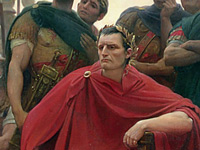 Julius Caesar (100-44 BC), was a Roman politician and general who played a critical role in the events that led to the demise of the Roman Republic and the rise of the Roman Empire. Caesar is considered by many historians to be one of the greatest military commanders in history. Julius Caesar » portrayed this invasion as being a preemptive and defensive action, most historians agree that the wars were fought primarily to boost Caesar's political career and to pay off his massive debts. Still, Gaul was of significant military importance to the Romans, as they had been attacked several times by native tribes both indigenous to Gaul and farther to the north. Conquering Gaul allowed Rome to secure the natural border of the river Rhine. The Gallic Wars are described by Julius Caesar in his book Commentarii de Bello Gallico, which remains the most important historical source regarding the conflict.
Julius Caesar (100-44 BC), was a Roman politician and general who played a critical role in the events that led to the demise of the Roman Republic and the rise of the Roman Empire. Caesar is considered by many historians to be one of the greatest military commanders in history. Julius Caesar » portrayed this invasion as being a preemptive and defensive action, most historians agree that the wars were fought primarily to boost Caesar's political career and to pay off his massive debts. Still, Gaul was of significant military importance to the Romans, as they had been attacked several times by native tribes both indigenous to Gaul and farther to the north. Conquering Gaul allowed Rome to secure the natural border of the river Rhine. The Gallic Wars are described by Julius Caesar in his book Commentarii de Bello Gallico, which remains the most important historical source regarding the conflict.
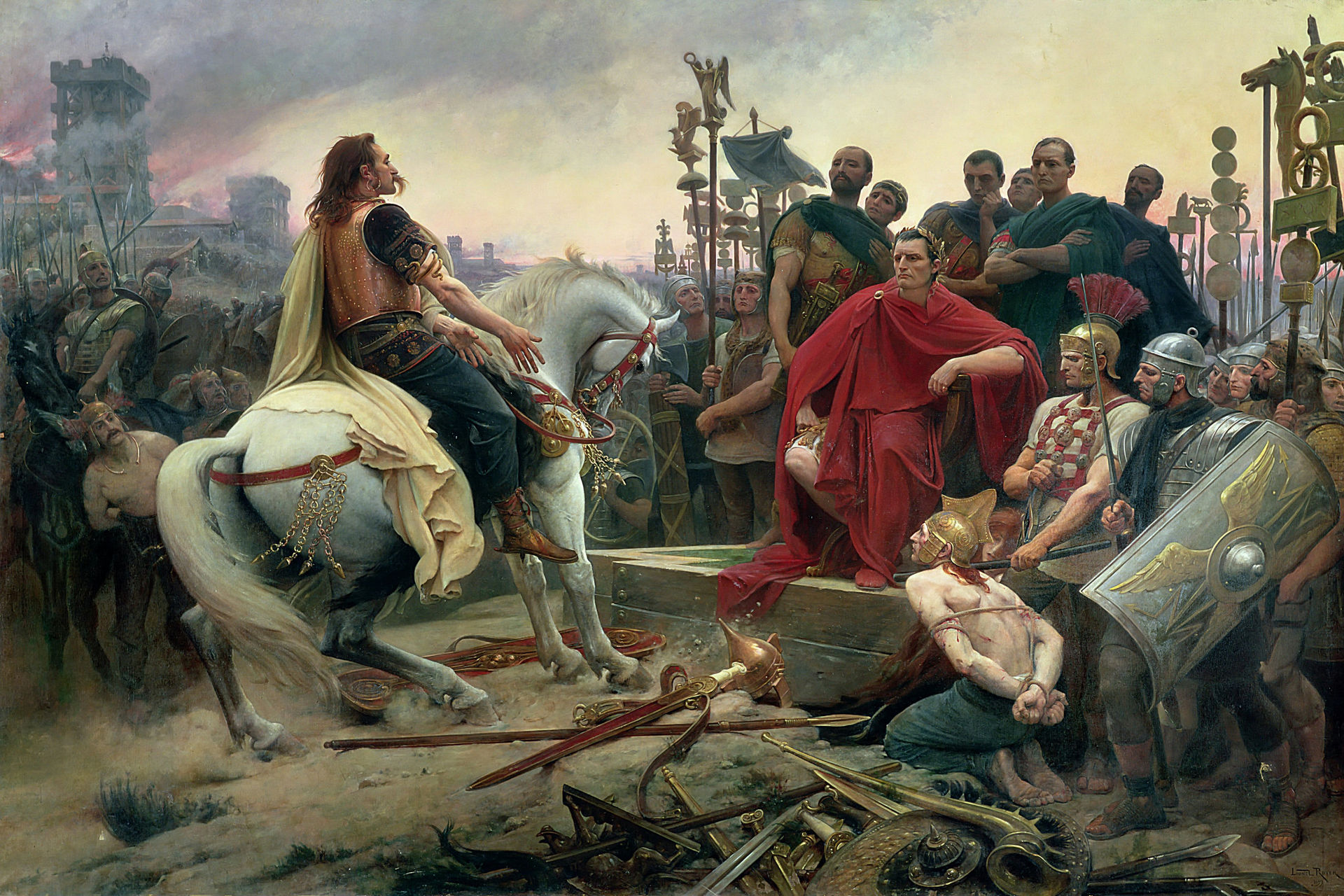
The painting depicts the surrender of the Gallic chieftain after the Battle of Alesia (52 BC). Note that one of the warriors (bottom left) has a torque around his neck. In fact, the torque was reserved only for gods and important members of a royal family. The depiction of Gauls with long hair and mustaches is also called into question today. The horse is a Percheron, although at this time this breed was not in Gaul. In addition, the Gauls rode bareback, but here the horse is saddled and harnessed. The rectangular shield also does not accord with the time when they were mostly oval.

The painting depicts the surrender of the Gallic chieftain after the Battle of Alesia (52 BC). Note that one of the warriors (bottom left) has a torque around his neck. In fact, the torque was reserved only for gods and important members of a royal family. The depiction of Gauls with long hair and mustaches is also called into question today. The horse is a Percheron, although at this time this breed was not in Gaul. In addition, the Gauls rode bareback, but here the horse is saddled and harnessed. The rectangular shield also does not accord with the time when they were mostly oval.
( Click image to enlarge)
HISTORY
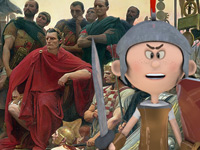
RESOURCES
This article uses material from the Wikipedia article "Gallic Wars", which is released under the Creative Commons Attribution-Share-Alike License 3.0.
© Stories Preschool. All Rights Reserved.
